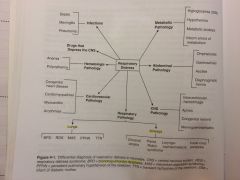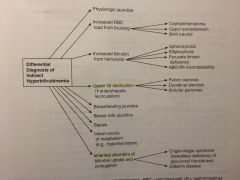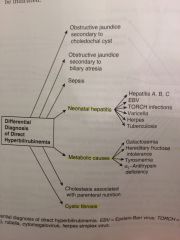![]()
![]()
![]()
Use LEFT and RIGHT arrow keys to navigate between flashcards;
Use UP and DOWN arrow keys to flip the card;
H to show hint;
A reads text to speech;
52 Cards in this Set
- Front
- Back
|
Apgar Score
A. highest B. category C. procedure |
A. 10
B. heart rate respiration muscle tone color reflex irritability C. every 5 min eval until 7 is reached |
|
|
Skin
A. premature infants B. lanugo C. vernix caseosa D. cutis marmorata E. pallor etiology F. milia G. mongolian spot H. pustular melanosis I. erthema toxicum neonatorum J. Nevus simplex"stork bit" J. Nevus flammeus "port wine stain" K. hemangioma L. neonatal acne |
A. softer and thinner
B. thin hair that covers skin of preterm infants C. thick, creamy material in term infants D. mottling of skin with venous prominence E. asphyxia, shock, sepsis, anemia F. tiny whitish papules around pilsebaceous follicules G. blue hyperpig macules ove rlumbosacral area H. transient rash of small dry superficial vesicles over dark macular base I. eosinophilic. erythematous macules on trunk but not on palms/soles J. pink macular lesion on nape of neck, nasolabial region K. vascular malformation of dilated capillary L. vascular tumors M. |
|
|
Sturge-Weber syndrome
|
nevus flammeurs in ophthalmic branch of trigeminal nerve
intracranial vascular malformation seizures intracranial calcification |
|
|
Microcephaly
- etiology |
CMV
TOXOPLASMOSIS FETAL ALCOHOL SYNDROME |
|
|
caput succedaneum
|
diffuse edema of scalp tha tcrosses cranial sutures/midline
|
|
|
cephalohematomas
|
- subperiosteal hemorrhage secondary to birth trauma
- limited by cranial sutures - parietla or occipital bones |
|
|
craniosynostosis
|
premature fusion of cranial sutures
|
|
|
craniotabes
|
soft areas of skull with ping pong ball fell
|
|
|
Eyes: red reflex
- lack etiology |
- retinoblastoma
- cataracts - glaucoma - chorioretinitis |
|
|
Pierre Robin syndrome
|
- micrognathia
- celft palate - glossoptosis - obstruciton of upper airway |
|
|
Clavicle Examination
A. lateral neck cyts B. midline clefts C. turner syndrome |
A. branchial cleft cysts, cystic hydromas
B. thyroglossal duct, goiter C. edema, webbing |
|
|
Chest deformities
A bulging sternum B. depressed sternum C poland syndrome |
A. pectus carinatum
B. pectus excavatum C. chest asymmetry b/c of lack of ribs or pectoralis muscle |
|
|
Respiratory distress signs
|
- tachypnea (>60)
- deep respiration - cyanosis - grunting - intercosta, sternal retractions |
|
|
Cardiac
- nl range - diminished femoral pulses - increased femoral pulses |
A. 95 - 180 bpm
B. coarctation of aorta C. patent ductus arteriosus |
|
|
Abdominal exam
A. umbilicus B. persistent urachus C. meconium plug D. meconium ileus E. diastasis recti |
A. if only 1 artery = congenital renal anomalies
B. fistula tw bladder and umblicus C. obstruction of left colon and rectum by dehydrated meocnium D. occlusion of distal ileum by insupissated def of pancreatic enzymes both sign of cystic fibrosis E. separation of lef tand right of rectus |
|
|
Abdominal mass differential
|
- hydronephrosis
multicystic kidney ovarian cysts |
|
|
Female genitalia
A. hypertrophied clitoris hydrometrocolpos |
A. androgen excess
B. imperforate hymen with retention of vaginal secretion |
|
|
Male genitalia
A. hypospadia B. epispadia C. hydrocele D. cryptochidism |
A. urethral meatus on ventral surface
B. meatus on dorsal. assoc with baldder exttrophy C. assoc w/ inginal hernia D. undescented deste |
|
|
Absence of radius (3)
|
- Fanconi anemia
- Holt-Oram syndrome - thrombocytopenia absent radii |
|
|
Edema of feet with pyoplastic nails
|
turner or nonran
|
|
|
Spina bifida
|
- hair tufts, dimple
|
|
|
Problems of pre-term babies
|
- necrotizing enterocolitis
- hypothermia, glycemia, calcemia - RSD - retinopathy of prematurity - bronchopulmonary dysplaisa - anemia - indirect hyperbilirubinemia |
|
|
Post-term
A. def B. complications |
A. >43 gestation
B. intrauterine asphyxia meconium aspiration syndrome polycythemia |
|
|
Small-for-gestational age (SGA)
A.def B. Causes |
A. below 5th percentile as a result of IUGR
B. causes of IUGR: TORCH, chromosomal anomalies, maternal drugs placental insuf, tumors maternal malnutrition, pregnancy induced hypertension |
|
|
Large for gestational age
A. def. differentiate from high birth weight B. Etiology |
A. >90th percentil.
high birth weight is > 4,000g B. maternal diabetes, Beckwith-Wiedemann syndrome Parder-Willi synd nesidioblastosis (diffuse, proliferation of pancreatic islet cells) |
|
|
Cyanosis
A. pathophysio B. etiology C. evaluation test |
A. absolute conc of unoxy or reduce dhemoglobin
B. 5 T: truncus arteriosus, tetrology of Fallot, tricuspid atresia, transposition, total anomalous pulmonary venous connection hematologic disorder (polycythemia) metabolic (hypoglycemia/calcemia/thyroidism) C. 100% O2 test: if heart dz = PaO2 not > 150mmHg if lung dz = > 150 mmHg |
|
|
Respiratory Distress
- Lungs - Airways - Cardio - CNS - Hematology - Infection |

|
|
|
Respiratory Distress Syndrome
A. pathophysio B. assessment C. risk factors |
A. lack of surfactant made after 30-32 wks
B. amniocentesis: lecithin-to-sphingomyelin >2:1 presence of phosphatidylglycerol C. prematurity, IDM, neonatal hypothermia/asphyxia |
|
|
RDS
A. clinical tx B. radiograph features C. tx D. complication |
A. 1st 24-48 hrs: tachpnea, grunting, cyanosis
B. ground-glass, air bronchograms = small airways with air surrounded by increased ensity of pulmonary field C. CPAP, oxygen, exogenous surfactant D. air leaks, bronchopulmonary dysplasisa ( = chronic lung disease, retinopathy of prematurity) |
|
|
Diagnosis of bronchopulmonary dysplasia
|
- mehcanical ventilation in 1st two weeks of life
- respiratory compromise beyond 28 days - supplemental O2 beyond 28 days of life - CXR |
|
|
Persistent Pulmonary Hypertension of Newborn (PPHN)
A. def B. etiology C. pathophsio D. evaluation E. tx |
A. any condition other than congenital HD associated to low blood flow to lungs
B. MAS, perinatal asphyxia C. incr pulmonary vascular R = R to L shunting = hypoxemia D. CXR = pulmonary vascualr markings decreased endocardiogram to rule out congential heart disease E. ventilation, oxygen, ECMO, nitric oxide for pulmonary dilation |
|
|
Meconium Aspiration syndrome
A. def B. pathophysio C. evaluation D. complication |
A. meconium = first stools
B. meconium-stained amniotic fluid (MSAF) is green. if becomes hypoxic, grasp, aspirate meconium C. CXR = incr lung volum with diffuse patchy area sfo atelectasis D. PPHN, bacaterial pneumonia long-term reactive airway disease |
|
|
Apnea of Prematurity
A. def B. types |
A. resp pause w/o airflow >15-20 sec
B. central apnea apnea secondary to airway obstruction (no airflow) mixed apnea C. GERD, anemia, hypo, seizures |
|
|
Idiopathic apnea of prematurity
A. tx |
respiratory stimulate meidcation: caffein, theophyllin
ventilation CPAP, mechanical ventilation |
|
|
Physiologic jaundice
A. def B. causes C. sx |
A. indirect hyperbilirubinemia and no tx required
B. incr bilirubin load on hepatocytes delayed activity of glucuronyl transferase C. in well-appearing infants and decr before 1st week |
|
|
Nonphysiologic Jaundice
A. name 2 types |
- indirect hyperbilirubinemia
- direct hyperbilirubinemia: always pathologic in neonates |
|
|
Indirect hyperbilirubinemia
A. pathophysio causes (3) B. breastfeeding jaundice C. brest milk jaundice |
A. excessive bilirubin
impaired clearance of bilirubin defective conugation of bilirubin by liver B. 1st week. poor milk intake = wt loss, dehydration, decr passage of stool = decr bilirubin excretion C. after 1st week, related to milk's beta-glucuronidase and lipase |
|
|
Differential indirect hyperbilirubinemia
|

|
|
|
Differential of direct hyperbilirubinemia
|

|
|
|
Evaluation of hyperbilirubinemia
A. indirect B. direct C. complications |
A. CBC, reti count, smear (for hemolysis)
B. hepatic US, serologies for viral hepatitis, radioisotope for heptobiliary tree C. kernicterus (basal ganglisa, hippocampuse) choreoathetoid cerebral palsy hearing loss opisthotonus (HTN, spasticity), seizure |
|
|
Infants of drug-abusing mothers
A. drugs B. cx |
A. alcohol, cocaine
amphetamines, narcotics B. jitteriness, hyperreflexia, feeding intolerance, excessive wakefulness, tremulousness |
|
|
Esophageal Atresia with Tracheoesophagela fistula
A. sx B. Dx |
A. polyhydramnios
incr liklihood of aspiration pneumonia (esp feeding) VACTERL association B. OG tube |
|
|
Congenital diaphragmatic hernia
A. pathophysio (which side) B. sx C. dx D. tx |
A. herniation impair growth ahd maturation of lungs, esp left side
B. polyhydramnios scaphoid abdomen, respiratory insuf C. CXR: no abdomen gas, no diaphragmatic dome D. bag-and-mask ventilation should NOT be used |
|
|
Abdominal wall defect
A. time line B. omphalocele C. gastroschisis |
A. 10th week
B. centrally in abdomen true hernia sac = covered by peritoneal sac assoc with other congential anomalies (heart) C. right paraumbilical area no peritoneal sac covering incr risk of ischemia/bowel damage |
|
|
Intestinal obstruction
A. most common type B. list 3 others |
A. intestinal atresia
B. meconium ileus, intestinal malrotation, Hirschsprung disease |
|
|
Meconium ileus
A. pathophysio B. sx C. dx |
A. neonatal manifestation of cystic fibrosis. intestinal secretion adn def of pancreatic enzymes incr viscosity of meconium = occlusion
B. abdominal distension, lack of meconium passage, vomiting C. CXR: soap-bubble appearance no definit air-fluid interface = air trappe din meconium |
|
|
Intestinal malrotation
A. causes |
A. volvulus: loops of intestine twist if attached to narrow band of mesentery
|
|
|
Hirschsprung diease
A. pasophysio B. sx C. dx D. tx |
A. lack of caudal migration of ganglion cells from neural crest = contraction of distal segment with proximal dilatation
B. constipation, vomiting, abdominal distention C. rectal biopsy D. colostomy, resect affect segment |
|
|
Necrotizing Enterocolitis
A. sx B. dx C. complication |
A. residual gastric contents, bloody stools
abdominal erthema, abdominal distention B. air-fluid levles pneumatosis intestinalis (air in bowel wall) C. intestinal obstruction nutritional deficiencies |
|
|
Hypoglycemia
A. def A. etiology C. sx |
A. <40 gm/dL
B. IDM (transient), nesidioblastosis (persistent) limited hepatic glycogen stores stressed, asphyxiated, sepsis growth hormone def, panhypopituitarism galactosemia, fructose intolerance C. jitteriness, feeding probelms, tachycardia, hypotonia |
|
|
Infants of diabetic mothers
A. pathophsio B. sx C. complication |
A. hyperglyemia -> hyperinsulinemia --> incr hepatic glucose uptake + lipogenesis = macrosomia
B. incr body fat, visceromegaly, head/face dispropor small C. congenital anomalies, small left colon syndrome: abd distentsion, failure to pass meconium secondary to decr caliber of left colon |
|
|
Polycythemia
A. def B. etiolgoy C. sx E. tx |
A. > 65%
B. pacental insuf --> erythropoietin secretion + RBC production C. NEC, poor perfusion, plethora D. partial exchange transufsion: remove blod and replace with normal saline |

